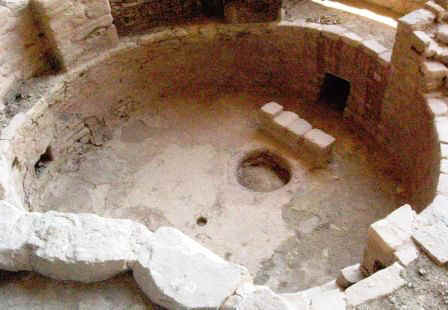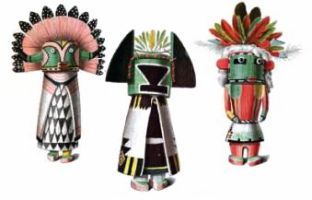Kivas
Definition of Kivas: What is a Kiva? A Kiva is a special sacred building, usually built underground, that is used for spiritual ceremonies, religious rituals and ceremonial preparations by the Pueblo Native Americans and strongly associated with the Kachina belief system. Kivas consisted of circular chambers built almost wholly underground with the entrance through a hatchway on top. A ladder, made with long poles pointing skyward, was used to access the hatchway. Prayer Sticks were prepared in the Kivas and used for various rituals and ceremonies, including the Kachinas, for calling forth spirits in the evocation of a prayer. Kivas were symbolic of the entry to the fourth world, the present world, and the hatchway symbolized the emergence from the other worlds, the home of the Kachina spirits.
Description of Kivas
The architecture of kivas is believed to have developed from the ancient pit houses that were used as dwellings by the ancients. Kivas have been built in many different sizes, the largest kivas are called great kivas. Kivas were constructed using wooden logs, adobe and stone. Adobe is a natural building material made from water, dirt and straw. The Ancient Pueblo builders used stones to make the walls of each room that were covered with a layer of smooth adobe. Kivas are round structures consisting of:
- Kivas had an enclosing wall with a built-in bench
- A packed earth floor
- A vent in the wall to provide fresh air
- Kivas had a firepit at the center
- Pillars to support the roof
- A flat roof of kivas was supported by hewn logs
- The roof is covered by small branches, matting, and a layer of earth
- The walls are decorated with murals of mythological figures of symbolic significance
- Kivas are entered through a roof hatchway by means of a ladder whose poles extend well above the flat rooftop
- A small hole or indentation in the floor of kivas called a 'Sipapu' symbolizing the portal through which their ancient ancestors first emerged to enter the present world.

Kivas - Picture of a Sipapu
Kivas - Domain of the Men
The Kivas were the sacred domain of the men and their secret rites. Historically, the men used kivas as both sleeping quarters and meeting rooms at various times of the year. The rites were concerned with rain-making, warfare, healing and hunting. Women were only allowed to enter the Kivas to take food to the men or to witness specific ceremonies. Modern kivas are used by men's ceremonial associations.
Kivas - Symbolic Emergence to the Fourth World
Kivas play a significant role in the Pueblo ceremonies, dances and rituals. The hatchway represents 'sipapuni', the emergence place, that symbolizes the portal through which their ancient ancestors first emerged to enter the present world, referred to as the Fourth world. The Pueblo and Hopi cosmology beliefs are based on the concept of two separate realms: the present world and the past worlds. They are divided into the eras of four worlds. The first three worlds were each destroyed until the people were led to the present world, the Fourth World:
- The first world was made by the Creator and the deities Sotuknang and Spider Woman taught the people to revere the creator, but the people forgot and the first world was destroyed by fire and the people who had remembered the Creator took refuge underground with the Ant People
- The Second World was created for their emergence from the underworld, it was beautiful like the first world but in the Second World the animals no longer trusted the humans. The people once again forgot the Creator and the world was frozen into solid ice and destroyed.
- The Third World was destroyed by floods
- The people were guided by the deities and emerged from the underworld to the Fourth World, earth
The other realm is the home of the Kachina spirits.

Native American Culture - Kivas
- Kivas - Pueblo rituals and customs
- Culture and History of PuebloNative Indians
- Interesting facts and info about Kivas for kids and schools
- Information about Kivas
- Native American Culture and beliefs for kids
- Description of Kivas
Kivas - Pictures and Videos of Native Americans
Spirit Stick. Discover the vast selection of pictures which relate to the History and Culture of Native Americans. The pictures show the clothing, War Paint, weapons and decorations of various Native Indian tribes that can be used as a really useful educational history resource for kids and children of all ages. We have included pictures and videos to accompany the main topic of this section - the Spirit or Kivas. The videos enable fast access to the images, paintings and pictures together with information and many historical facts. All of the articles and pages can be accessed via the Native Indian Tribes Index - a great educational resource for kids.